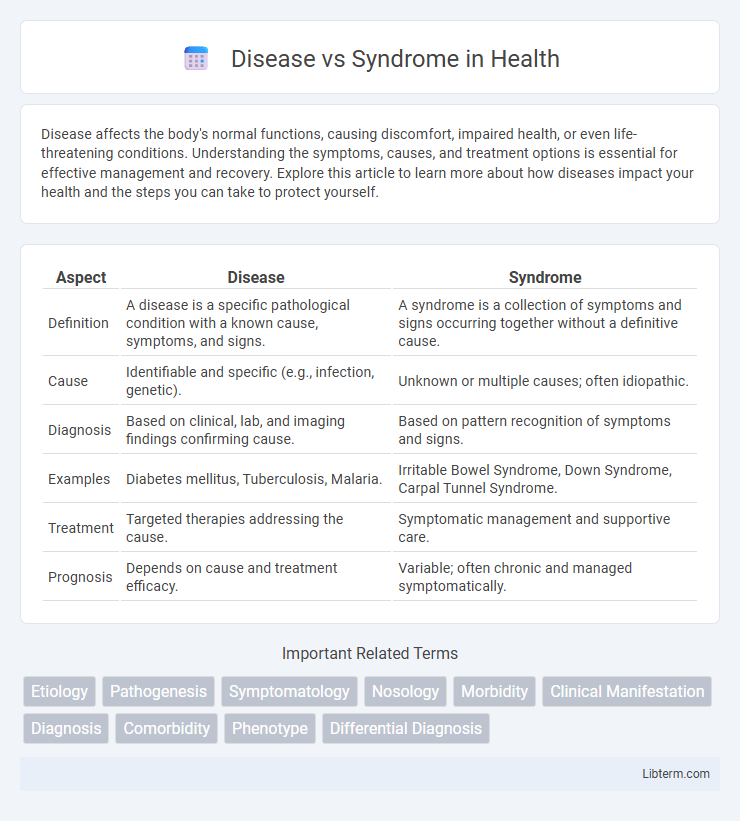Disease affects the body's normal functions, causing discomfort, impaired health, or even life-threatening conditions. Understanding the symptoms, causes, and treatment options is essential for effective management and recovery. Explore this article to learn more about how diseases impact your health and the steps you can take to protect yourself.
Table of Comparison
| Aspect | Disease | Syndrome |
|---|---|---|
| Definition | A disease is a specific pathological condition with a known cause, symptoms, and signs. | A syndrome is a collection of symptoms and signs occurring together without a definitive cause. |
| Cause | Identifiable and specific (e.g., infection, genetic). | Unknown or multiple causes; often idiopathic. |
| Diagnosis | Based on clinical, lab, and imaging findings confirming cause. | Based on pattern recognition of symptoms and signs. |
| Examples | Diabetes mellitus, Tuberculosis, Malaria. | Irritable Bowel Syndrome, Down Syndrome, Carpal Tunnel Syndrome. |
| Treatment | Targeted therapies addressing the cause. | Symptomatic management and supportive care. |
| Prognosis | Depends on cause and treatment efficacy. | Variable; often chronic and managed symptomatically. |
Understanding Disease vs Syndrome: Key Definitions
Disease refers to a specific pathological condition with identifiable signs, symptoms, and consistent causes, often confirmed through diagnostic tests. Syndrome describes a set of medical signs and symptoms that occur together without a clearly defined cause, representing a clinical pattern rather than a confirmed disease. Distinguishing disease from syndrome is crucial for accurate diagnosis, treatment planning, and medical research.
Causes: How Diseases and Syndromes Develop
Diseases develop from identifiable causes such as infections, genetic mutations, environmental exposures, or lifestyle factors, leading to specific pathological changes in the body. Syndromes arise from a constellation of symptoms and signs that often stem from multiple underlying conditions or complex genetic interactions without a single identifiable cause. Understanding the distinct etiologies of diseases and syndromes is crucial for accurate diagnosis and targeted treatment strategies.
Symptoms and Signs: Differentiating Disease from Syndrome
Symptoms are subjective experiences reported by patients, such as pain or fatigue, while signs are objective findings observed by clinicians, like a rash or fever. A disease is characterized by a specific pathological cause and consistent set of signs and symptoms, enabling a clear diagnosis. In contrast, a syndrome represents a collection of signs and symptoms that occur together without a definitive underlying cause, often requiring further investigation to identify the root disease.
Diagnosis Criteria: Disease vs Syndrome
Disease diagnosis criteria rely on identifying a specific pathological process or cause, confirmed through clinical tests, laboratory findings, and imaging, to establish a definitive diagnosis. Syndrome diagnosis is based on a consistent group of symptoms and signs occurring together without a single identifiable cause, often requiring pattern recognition and exclusion of other conditions. Diagnostic accuracy for diseases typically involves objective biomarkers, while syndromes depend more on clinical judgement and symptom clustering.
Pathophysiology: Mechanisms Behind Diseases and Syndromes
Disease pathophysiology involves identifiable structural or functional abnormalities in cells, tissues, or organs caused by specific etiological agents like pathogens or genetic mutations. Syndrome pathophysiology refers to a collection of signs and symptoms without a single identifiable cause, often resulting from complex interactions of multiple pathophysiological mechanisms. Understanding these mechanisms aids in differentiating diseases with defined pathological changes from syndromes representing broader clinical manifestations.
Examples: Common Diseases and Syndromes
Diabetes mellitus and hypertension are common examples of diseases characterized by specific causes and clear diagnostic criteria, such as high blood sugar levels and elevated blood pressure, respectively. In contrast, syndromes like Down syndrome and metabolic syndrome consist of a collection of symptoms and signs that occur together without a single known cause; Down syndrome results from chromosomal abnormalities, while metabolic syndrome includes a cluster of conditions like insulin resistance, abdominal obesity, and dyslipidemia. Understanding the distinction between diseases and syndromes aids in accurate diagnosis and targeted treatment strategies.
Treatment Approaches: Managing Disease vs Syndrome
Treatment approaches for diseases often target the specific causative agent or pathological process, such as antibiotics for bacterial infections or chemotherapy for cancer. Managing syndromes requires a broader strategy that addresses multiple symptoms and underlying conditions simultaneously, frequently involving multidisciplinary care teams. Personalized treatment plans in syndromes focus on alleviating composite clinical features rather than eradicating a single identifiable cause.
Prognosis and Outcomes: Disease vs Syndrome Comparison
Disease prognosis often depends on the specific pathology and underlying causes, allowing for more targeted treatment and predictable outcomes. Syndromes, characterized by a collection of symptoms without a single identifiable cause, generally have variable prognoses influenced by the heterogeneity of their underlying conditions. Outcomes in diseases are usually more standardized, while syndromic outcomes require personalized management strategies due to their complex and multifactorial nature.
Misconceptions and Common Confusions
Disease refers to a specific pathological condition with identifiable causes and symptoms, while syndrome describes a set of signs and symptoms that often occur together without a clearly defined cause. Common misconceptions arise when people use disease and syndrome interchangeably, overlooking that syndromes may include multiple diseases or conditions with varied origins. This confusion impacts diagnosis and treatment approaches, highlighting the importance of distinguishing between etiological factors in diseases and the symptomatic patterns in syndromes.
Importance of Distinguishing Disease from Syndrome in Medicine
Accurate differentiation between disease and syndrome is critical in medicine for effective diagnosis and treatment planning. Diseases have specific etiologies and pathophysiological processes, while syndromes represent a cluster of symptoms without a single identifiable cause. Understanding this distinction enhances patient management, informs prognosis, and guides targeted therapeutic interventions.
Disease Infographic

 libterm.com
libterm.com